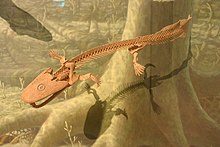Acanthostega
|
Acanthostega Temporal range: Late Devonian, 365 Ma |
|
|---|---|
 |
|
| Skeletal reconstruction | |
| Scientific classification | |
| Kingdom: | Animalia |
| Phylum: | Chordata |
| Class: | Sarcopterygii |
| Clade: | Tetrapodomorpha |
| Genus: | Acanthostega |
| Species: | A. gunnari |
| Binomial name | |
|
Acanthostega gunnari Jarvik, 1952 |
|
Acanthostega (meaning "spiny roof") is an extinct genus of stem-tetrapod, among the first vertebrate animals to have recognizable limbs. It appeared in the late Devonian period (Famennian age) about 365 million years ago, and was anatomically intermediate between lobe-finned fishes and those that were fully capable of coming onto land.
The 60 cm (24 in) Acanthostega had eight digits on each hand (the number of digits on the feet is unclear) linked by webbing, it lacked wrists, and was generally poorly adapted for walking on land. It also had a remarkably fish-like shoulder and forelimb. The front foot of Acanthostega could not bend forward at the elbow, and thus could not be brought into a weight bearing position, appearing to be more suitable for paddling or for holding on to aquatic plants. Acanthostega is the earliest stem-tetrapod to show the shift in locomotory dominance from the pectoral girdle to the pelvic girdle. There are many morphological changes that allowed the pelvic girdle of Acanthostega to become a weight-bearing structure. In more ancestral states the two sides of the girdle were not attached. In Acanthostega there is contact between the two sides and fusion of the girdle with the sacral rib of the vertebral column. These fusions would have made the pelvic region more powerful and equipped to counter the force of gravity when not supported by the buoyancy of an aquatic environment. It also had lungs, but its ribs were too short to support its chest cavity out of water, and it also had internal gills that were covered like those of fish, as opposed to some modern amphibians that are fully aquatic.
It has been inferred that Acanthostega probably lived in shallow, weed-choked swamps, its legs being not an adaptation to walking on land. Jennifer A. Clack interprets this as showing that Acanthostega was primarily an aquatic animal descended from fish that never left the sea, and that the specializations in the tetrapod lineage developed features which would later be useful for terrestrial life. At that period, deciduous plants were flourishing and annually shedding leaves into the water, attracting small prey into warm oxygen-poor shallows that were difficult for larger fish to swim in; Clack remarks on how the lower jaw of Acanthostega shows a change from those of fish that have two rows of teeth, with a large number of small teeth in the outer row, and two large fangs and some smaller teeth in the inner row. This difference likely corresponds to a shift in stem-tetrapods from feeding exclusively in the water to feeding with the head above water or on land.
...
Wikipedia
